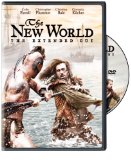| Reviews & Columns |
|
Reviews DVD TV on DVD Blu-ray 4K UHD International DVDs In Theaters Reviews by Studio Video Games Features Collector Series DVDs Easter Egg Database Interviews DVD Talk Radio Feature Articles Columns Anime Talk DVD Savant Horror DVDs The M.O.D. Squad Art House HD Talk Silent DVD
|
DVD Talk Forum |
|
|
| Resources |
|
DVD Price Search Customer Service #'s RCE Info Links |
|
Columns
|
|
|
New World - The Extended Cut, The
New Line // PG-13 // October 14, 2008
List Price: $20.98 [Buy now and save at Amazon]
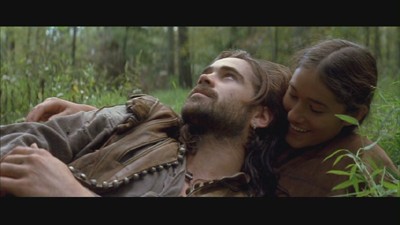
Days of Heaven director Terrence Malick has this tendency of releasing films only, oh, say every 10+ years or so. As he gets closer to finishing one of his projects, he edits the thing to death to make certain it flows just the way he wishes. The New World isn't only not an exception, it's a victim of sorts; before it made its theatrical debut sitting at about fifteen-minutes over two hours, a 150-minute cut made the rounds right before award season. Seemingly displeased with the end result, he withdrew the film from release and took it back to the cutting table. What resulted after these edits, to a finite point, is still an achievement of deliberate, visually awe-inspiring prose. Yet, the rumors of all this raw footage left on the cutting-room floor started circulating, and the scattered devout fans of The New World -- along with general fans of its director -- began salivating. Including yours truly.
In an interesting turn, New Line has released an "extended" cut of this beautiful piece of work, but it's not the same two-and-a-half hour cut that circulated during award season -- nor the oft-rumored multi-hour mystery cut. Here, Terrence Malick's The New World has been broadened to a hefty 172 minutes, just a shake underneath three hours. Is it one of those grand scale makeovers in the lineage of Kingdom of Heaven or Jet Li's Fearless? In so many words, no. Instead, it's the epitome of its descriptive title, as it mainly extends pre-existing scenes to even more sumptuous degrees of splendor. There's a few new sequences spliced into the film that spice up the narrative flow a bit, but the overall feel can better be summed up as taking the scenic route through already-gorgeous scenery. For most films, dumping more material into an already consciously-paced film would be a waste of time and resources; in the case of Malick's work -- especially the photography-bound The New World -- it's an effort that's far beyond welcome towards reinvigorating his initial vision.
The Film:
Everyone who has either read early American history books or seen the Disney animated film Pocahontas carries some grasp on the story at-hand: it's the tale focusing on the settlement of Jamestown, a rogue settler named John Smith (Colin Farrell, In Bruges), and the native woman Pocahontas (Q'orianka Kiltcher) who saved his life from certain execution by the other tribesmen. Malick's rendition of the semi historically-backed tale decides to push both ends of the possible spectrums for his telling, placing emphasis on both on the sensual bond between Smith and Pocahontas as well as the conflict-sparking communication barriers between the settlers and the Native Americans. His romantic notions get the best of him here, leading him down the romantic path through their blissful years together amid the tribe. But it's short lived, as Capt. Smith must return to his Jamestown post to tend the starving, desperate settlers rotting away in the Jamestown colony.
It's a story that, if told right, can be pegged down in a handful of sentences, yet it's in the cultural assimilation and the brevity in connecting with nature that push The New World's expansiveness towards soulful resonance -- both in Smith's grasping of native culture and Pocahontas' metamorphosis underneath the microscope of society. At first it establishes itself as an analysis on Smith, trekking him through the bones and filaments of tribal life. He's a man who has, in a sense, been reborn in Jamestown; Malick runs with this, treating his time with the natives as a "right place, right time" scenario that shapes him into something closer to the eclectic, spiritual model of Native American men. With his growing appreciation for wilderness existence, he also builds a grand appreciation for its children -- namely Pocahontas herself.
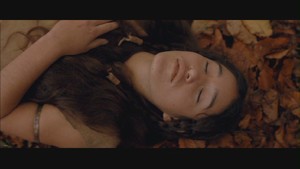
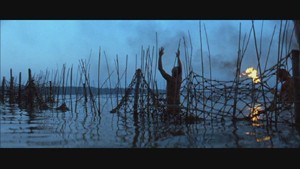
The New World takes its sweet time in guiding through Smith and Pocahontas' courtship, which is a signature move from visual artist Malick. He has a knack of keeping pace with his stories in a minimal-dialogue fashion that hitch a ride on the momentum of sumptuous cinematography. It's very difficult to keep a film going purely on landscape pans and subtle body-movement expository shots, yet Malick exploits his grasp on cinematic beauty to build the settlement's environment into a character of its own. Due in large part to immaculate, endlessly-researched production design surrounding the tribe's territory and Jamestown's crumbling fort-like structure, The New World's aesthetic prowess crafts en environment perfect for taking a gorgeous glimpse into the past.
Photographed on the Chicahominy River, a location very close to the original Jamestown, The New World takes the idea of untapped landscape beauty -- as well as the pristine, unblemished nature of the tribal people -- and amplifies it to astonishing proportions. Malick and Children of Men cinematographer Emmanuel Lubezki exhume organic browns and greens for their visual style, along with natural materials for everything from the boats to the clothing. There's beauty to be had around every bend of a creek and every sedentary wall, but it's a unique form of sumptuousness fashioned by ornate, realistic composition that beams with historical refinement.
Watching the performances in The New World reveals certain shifts in acting gravity, as it becomes a prime display of the weightlessness that blissful societal disconnect offers -- as well as a exposition on how venturing from nature can quickly wear its children down. Obviously, John Smith covers the "becoming one with nature" spectrum. I'm not sure what possessed Terrence Malick to cast the Minority Report and American Outlaws' rising star Colin Farrell, of all people, to play American pioneer John Smith, but he obviously saw a distinct dramatic quality that most didn't. Farrell's portrayal is surprisingly meditative, though his efforts work much better when he's keeping his mouth shut and tapping into unspoken emotion through body movements and gradual demeanor shifts. His innate masculinity intermingles skillfully with the prolific Native American cast, highlighted by the likes of Last of the Mohicans' Wes Studi and Free Willy's August Shellenberg. A large chunk of the visceral enjoyment to be had in The New World, similar to Gibson's Apocalypto, comes in glancing through the keyhole at an ancient culture. This dynamic provides a strong secondary foundation that helps to back up the emotionality and believability behind Capt. Smith and Pocahontas' relationship.
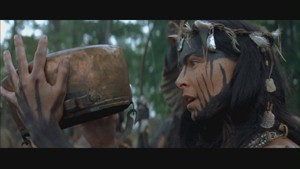
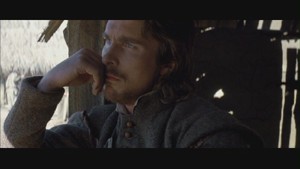
Of course, the real show-stealer is, as expected from early glimpses into The New World's trailers and marketing work, then-14-year-old Q'orianka Kiltcher, whose portrayal shatters all expectations one might have of a live-action version of Pocahontas. One or two scattered women stand out as visible entities in the tribe and in the Jamestown colony once it begins to boom, but in large part she's the only real feminine presence in the film -- and certainly the only one that we connect with. Kiltcher becomes, in turn, fascinating to watch as the near-ethereal embodiment of the Native American way of life, displaying properties about her physical projection that closely mirror deer-like grace and purity. It's actually pretty easy to buy into her and Farrell's bond as Smith and Pocahontas, something that becomes easier to see once it starts to crumble due to the colliding tensions between the tribesmen and settlers. Following her as she connects with a second Englishmen might've transitioned weakly during this stray from her native instincts, yet Kiltcher telegraphs this pivotal shift well as she plays off Christian Bale's intentionally indistinct performance as tobacco baron John Rolfe.
The New World transcends from a narrative-driven story into a poetic character study of sorts with these performances, one that relies heavily on illustrating the fading splendor of naturist purity -- along with the impact that the likes of gunpowder, gluttony, and ethnocentrism can have on its longevity. Terrence Malick discreetly makes this time pass before our eyes so that we might further absorb the primal interplay between characters, a struggle existing both on the native front and the Jamestown location that adds more brevity to the flow of the film than actual events occurring in its timeline. In that, the film becomes a beautiful allegorical divulgence of pure love instead of an event-based drama, which is easily its strongest asset. Malick's an inspiring visual lyricist, and if it takes him double-digit year spans to construct films with as much brevity and poise as The New World, then let's not rush the man between these gaps.
Theatrical vs. Extended Cut:
So, let's talk brass tacks here. How does the "Extended Cut" differ from the theatrical cut, aside from just being over a half-hour longer in minute count? The difference isn't earth-shattering, but it's certainly a welcome range of seamlessly-added earmarks. Just don't expect a narrative rearrangement on a grand scale, because The New World looks and feels just about the same as it does in it shorter concoction -- only with enhanced beauty, sensuousness, and poeticism in many, many shots.
Venturing a guess after side-by-side comparisons of the cuts, I'd say that around 40-50% of the new material is a range of minor extensions, like prolonging a few spans of Smith's first rowboat trip to the tribe's location, lengthening John Smith's play time with the tribesmen, or extending the tribe's approach to Jamestown during the winter. Since they're so effortlessly fused into the runtime, they're welcome additions that, surprisingly, never slow down the pace. They amount to more Malick-style capturing of landscapes that we already get lost in with the theatrical cut -- so, essentially, it's more of the same photography. And that's a good thing.
Yet, they've also been edited together a little differently in spots, along with re-engineered voiceovers and score accompaniment. It's hard to pinpoint exactly why, but the arrangement of a few scenes seem more fluid - especially the new audio reworking, which engineers these new scenes to be seamless with the film's rhythm. There's also new implementation of Chapter Timecards that segment the film into distinct chapters. I'm still not certain how I feel about these, though they do add a dash of panache in preparing the viewer for the coming shots and in incorporating time-aware segmentation for ease in conveying time placement.
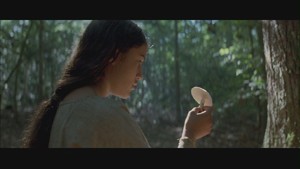
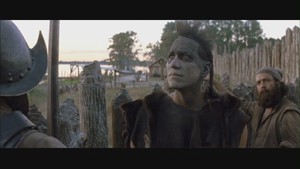
The other half of this new material doesn't affect the canon of the story, but it does add personality and depth of tone to The New World's rhythm. SPOILER ALERT --- There's an extended conversation between David Thelwis' snarky character and Christopher Plummer's Capt. Newport that further enhances the discomfort in sending Smith to the "savages", as well as further dynamic-enhancing scenes later on in the developing settlement. We're also working with a stretch of film that shows a tribesman intermingling with the Jamestown settlers in chummy fashion, some gorgeous new nature shots involving Pocahontas reconnecting with nature, as well as a potent conversation between Pocahontas and her uncle near the close of the film. She also receives a lot more face-time in the Jamestown settlement, certainly only edited down due to the film's length -- because the material is very good. Furthermore, we're allowed to see brief flashes of Pocahontas' mother weaving through tall grass, matched with some stretches of truly resonant mother-focused narration in subsequent areas. In fact, most of the substantial added footage revolves around enhancing Pocahontas' spiritual essence. --- END SPOILER ALERT.
Outside of that, the film's flow is largely similar to its theatrical distribution, just with extra padding in the editing to make it an even-more expansive and beautiful picture that rarely slows down in pace. To choose a preference between the two is tough, especially since they both reach the same destination by taking two equally-beautiful routes -- one in shorter time and the other with expanded leisurely enjoyment. However, the next journey I take into The New World will certainly be with this new Extended Cut. There's a lot of extra Malick goodness reinvigorated into this lengthier cut, including some astonishing nature visuals that really should NOT have been clipped from the final print. It takes longer to soak in this Extended Cut of The New World, but its elaborative beauty would be the way I'd suggest you to go if you're able to have patience with deliberately-paced historical drama accompanied by astonishing visual design.
The DVD:
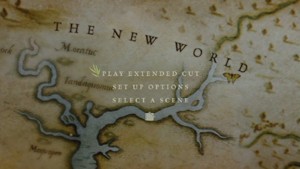
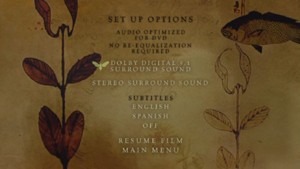
New Line Home Entertainment presents The New World: Extended Cut in a standard keepcase presentation with sepia-toned coverart featuring an attractive piece of sketch-art that slightly misrepresents a scene from the film. With it comes a slipcover that should look rather familiar; if you purchased a copy of Malick's film from Best Buy, then you might have snagged a copy with the exclusive alternate artwork as the slipcover. Aside from a few Photoshop enhancements (shadowing on text, different spine, etc.) and a different back cover, it's basically the exact same thing.
The Video:
The New World's 2.35:1 widescreen presentation, enhanced for 16x9 televisions, has provided a more difficult visual evaluation than expected. Expectations led towards this disc having close to the same transfer considering coloring and detail - with incorporation of these new scenes jammed into the print. Here's the odd thing: The New World looks to have been color-timed a bit differently this second go-around. Many scenes share almost identical visuals regarding palette usage, whereas several others are either more saturated in this new print -- or LESS saturated, in many cases. Whether these are some of Terrence Malick's implementations isn't a readily-available bit of information, but until heard otherwise this new transfer is a marked improvement over the original release.
Click on Each Image for a Larger Capture
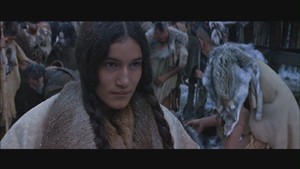
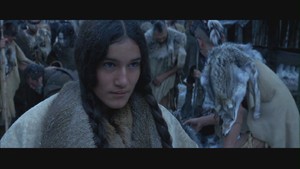
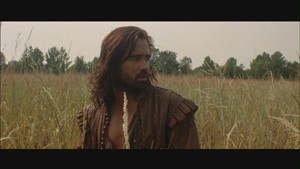
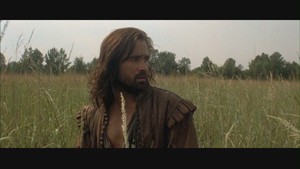
When comparing to the 2005 theatrical DVD, this New World disc looks more natural in regards to skin tones (which seem awfully red in the old edition) and scenery shots. Greens pop a lot more, as does the sharpness involving details visible in shaded areas and facial structures. Though one or two scenes can flicker and speckle up a bit in darker scenes, the concentration on black levels here renders more well-pitched shadows and contrasts. One interesting thing to watch for is the framing, as it seems like the image was matted little further up on the negative ... and a little closer in, thus making some scenes lose an unnoticeable hairline amount of material on each side.
One problem that existed with the older DVD was a wavering grasp on edge enhancement, something that sadly carries over a little bit into this new edition. A different problem arises on this newer disc: since this is a three-hour film front-loaded onto a single disc, the compression can be a little wonky. Therefore, some shots of the sky and such can seem a tad noisy and a bit too digitally-processed. There are only a few issues with this new transfer of The New World, but the measures taken to improved the visual quality step well above a few slight digital problems -- all of which look smashing for being contained on one single-disc DVD. Overall, the result lends a rich, beautifully natural palette to the image that makes the film even more beautiful to behold.
The Audio:
Incorporated into this new cut of The New World are several shifts in narration and score, which sound seamless in this Dolby Digital 5.1 track. The surround experience relies vastly on the score and ambient effects of nature, which both sound absolutely splendid here. Verbal clarity also comes across with top-shelf quality, rarely straining for audibility. From the rustling of grassblades and the firing of artillery to the native's tribal yells, everything here resonates splendidly with exceedingly high competence in dynamic range. As for comparison between the previous track, you'll notice a slight boost in clarity between the two releases -- with a noticeable concentration on mid-range fidelity. The mixes are largely similar in regards to surround effect, but overall this is a marginally stronger audio effort. English and Spanish subtitles are available for the 5.1 and Dolby 2.0 Stereo tracks.
The Extras:
If you purchased the original theatrical disc, there's at least one reason to hold onto it: the supplemental features. Sadly, they have not been carried over to the Extended Cut DVD -- including a stellar multi-sectional making-of assortment -- nor have any special features of any shape, form, or fashion been included. Not even a trailer makes it onto this disc, which is pretty darn disappointing considering the sordid history of The New World's editing problems and critical acceptance.
The only bonus is the opportunity to grab a Digital Copy of the film via New Line's now-recurring download option.
Update: After working through the download process, which involves obtaining a new program to pull the file from the http://www.cinemanow.com website, an interesting development has come up: the digital file's runtime is 2:30:06 -- the same span as the initial cut -- while holding a storage capacity of 2.47 GB. Whether or not this is the rumored previous version or not cannot be established, but it can be confirmed that this is NOT the full Extended Cut.
-----
Final Thoughts:
In its shorter edit and amid critical wishy-washy pandering, The New World still knocked me aback with an awe-inspiringly simple story bolted onto signature Terrence Malick visual composition. From aesthetic refinement to the ranged selection in actors, this rendition of Pocahontas' semi-historical rendezvous with John Smith took me by surprise. Yes, I can be a sucker for sweeping photography -- especially when it's poetic -- which probably plays into my affection for The New World. However, in its simple storytelling, poetic narration, and resounding primal beauty, it's a film that'll probably hit me with each time through.
Now, that experience has extended from two-and-a-quarter hours to a near three-hour indulgence in The New World: Extended Cut. The additions are enough to further ignite my admiration for the work, yet not profound enough to change my observation on its beginning-to-conclusion impression. In other words, this is an even-more-scenic route worth taking, especially for Malick fans, but something that probably won't change your mind about its quality if you didn't favor it before. Considering the low price-tag (along with the availability to snag the previous disc at inexpensive prices for the making-of docs), the marginally-enhanced aural / visual quality, and the sheer opportunity to soak in more of an already-beautiful film, this extended cut of The New World comes eagerly Recommended, even higher for fans of the theatrical distribution that wanted more. Coughing up around $20 to get both the Theatrical DVD with supplemental materials and this Extended Cut, however, would be considered a highly recommended series of purchases for that price.
|
| Popular Reviews |
| Sponsored Links |
|
|
| Sponsored Links |
|
|
| Release List | Reviews | Shop | Newsletter | Forum | DVD Giveaways | Blu-Ray | Advertise |
|
Copyright 2024 DVDTalk.com All Rights Reserved. Legal Info, Privacy Policy, Terms of Use,
Manage Preferences,
Your Privacy Choices | |||||||









